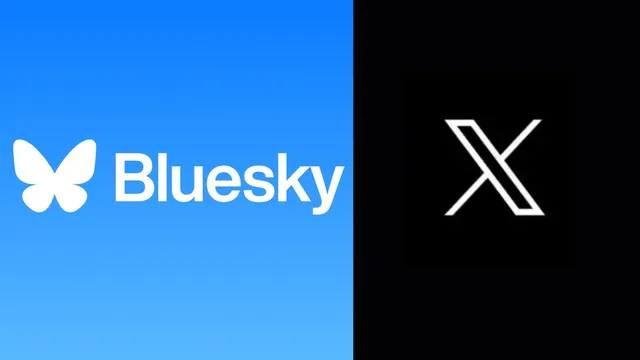Your cart is currently empty!
Social Media
X vs BlueSky : Know The Differences

The Differences Between X (formerly Twitter) and Bluesky: A Comparative Analysis
The social media landscape has undergone significant shifts in recent years, with platforms evolving or emerging to meet the demands of a changing digital world. Two notable players in this space are "X" (formerly Twitter) and Bluesky, both of which cater to users seeking microblogging experiences but differ in their approaches, features, and philosophies. Understanding these differences can help users navigate which platform better suits their needs.
Ownership and Development Background
X (formerly Twitter)
X was originally launched as Twitter in 2006 by Jack Dorsey, Biz Stone, and Evan Williams. Over the years, Twitter became a global phenomenon, known for its concise 280-character posts, or "tweets." The platform facilitated real-time news, political discourse, and entertainment conversations. However, in 2022, Twitter underwent a dramatic shift when Elon Musk acquired the company, and it was rebranded as X in 2023. Musk’s vision for X includes transforming it into a more comprehensive “everything app,” similar to China’s WeChat, with added features like social media, finance, and commerce.
Bluesky
Bluesky was created as a project by Twitter co-founder Jack Dorsey. After stepping down as CEO of Twitter, Dorsey continued to advocate for decentralized platforms, which led to the creation of Bluesky. The project was incubated under the auspices of Twitter, and in 2023, Bluesky launched as a separate, decentralized platform built on the AT Protocol. Unlike Twitter, Bluesky's core principle revolves around decentralization, providing users with greater control over their data and how content is moderated.
Core Philosophy and Approach
X
Under Elon Musk's leadership, X is shifting toward an all-encompassing platform, often referred to as an "X app." Musk's vision includes integrating various features into the app, such as messaging, payment systems, and social media, aiming to create a single platform where users can do everything from posting thoughts to transferring money. However, this vision has been met with challenges, especially around content moderation, privacy concerns, and user experience.
Bluesky
Bluesky, on the other hand, emphasizes decentralization and open-source protocols. It is designed around the principle of federated networks, allowing different instances or "servers" to interact with each other while maintaining local autonomy. This means that Bluesky users can participate in an open network without being bound to one single company’s control. The idea is to let communities set their own rules and operate independently, reducing the concentration of power that large tech companies like Twitter or Facebook hold over user data and content moderation.
Content Moderation
X
X's content moderation policies have been a point of contention since Musk’s acquisition. Under Musk, X has adopted a more lenient approach to free speech, reversing some of the stricter content bans, particularly concerning political speech and controversial figures. However, this shift has also led to an uptick in hate speech, misinformation, and harassment, which has raised concerns from users, advertisers, and regulatory bodies alike. Musk's approach to content moderation relies more on artificial intelligence tools and community reporting, but this has been controversial in how inconsistently it’s applied.
Bluesky
Bluesky, while still in its early stages, offers a more granular level of control for users when it comes to content moderation. Because of its decentralized nature, content rules are determined by the individual instances or communities users choose to join. This offers a more customizable experience for users, allowing them to join networks with policies that align with their preferences. Since Bluesky has yet to scale to the same level as X, it remains to be seen how effective its content moderation practices will be as the platform grows.
User Experience and Features
X
X (formerly Twitter) has retained many of its familiar features, such as short text posts (tweets), multimedia sharing, trending topics, and direct messaging. However, since Musk’s acquisition, the platform has integrated new features like X Premium, offering users additional benefits like verification badges, enhanced video quality, and access to exclusive content. X has also experimented with introducing a subscription model, giving users the ability to pay for enhanced services. X has streamlined the user experience toward its goal of becoming an all-encompassing social hub.
Bluesky
Bluesky operates with a similar base structure of text-based posts, but with a focus on a cleaner and less cluttered user interface. Its features currently include the ability to post and reply to messages, follow other users, and interact via reposting. However, Bluesky’s key difference lies in its AT Protocol, which aims to enable interoperability across platforms. The decentralized nature means that users have more control over how their posts and content are displayed. As the platform develops, new features related to customization and cross-platform engagement are expected to roll out.
Audience and Reach
X
As one of the largest and most well-known social media platforms, X boasts a massive user base, with millions of active users globally. X is a hub for diverse conversations, ranging from celebrity gossip to political debates and breaking news. However, with Musk’s changes to the platform, some users have left or reduced their activity on X, while others have flocked to it due to its relative freedom of speech.
Bluesky
Bluesky is still in its infancy, with a much smaller user base compared to X. It has attracted users who are disillusioned with centralized platforms and those who are looking for a more decentralized, community-driven experience. Bluesky is still cultivating its audience, with a strong focus on attracting early adopters, tech enthusiasts, and those interested in the future of social media decentralization.
Monetization and Advertising
X
X has integrated advertising deeply into its platform, relying on its vast user base to generate revenue for the company. It also launched X Premium, a subscription model that monetizes certain premium features, such as verification badges and additional content visibility. This allows X to capitalize on both user engagement and advertiser interest.
Bluesky
Bluesky is still exploring how to generate revenue, but its decentralized nature presents challenges when it comes to traditional advertising. The platform's emphasis on user privacy and the decentralization of data means that ads, if implemented, would likely be less intrusive compared to those on centralized platforms. Bluesky is also experimenting with more user-controlled monetization options, where users may choose to pay for additional features or support independent instances financially.
Conclusion: Which Platform Should You Choose?
The choice between X and Bluesky largely depends on what kind of social media experience you value. X (formerly Twitter) remains a more established platform with a vast user base, robust features, and an evolving vision under Elon Musk's leadership. It’s ideal for users seeking an all-in-one app that merges social media, commerce, and finance, despite concerns over content moderation and privacy.
Bluesky, on the other hand, offers a fresh take on social media, emphasizing decentralization, user control, and open-source innovation. It’s an appealing option for users who prioritize privacy, freedom from centralized control, and the ability to shape their own community rules.
As both platforms continue to evolve, the future of social media may lie in finding a balance between the two approaches—centralized convenience versus decentralized autonomy. Time will tell how both X and Bluesky shape the next era of digital communication.

